Physical Address
304 North Cardinal St.
Dorchester Center, MA 02124
† Deceased.
Thoracic outlet syndrome, a term coined by Rob and Standover, refers to compression of the subclavian vessels and brachial plexus at the superior aperture of the chest. It was previously designated, according to presumed etiologies, as scalenus anticus, costoclavicular, hyperabduction, cervical rib, and first thoracic rib syndromes . The various syndromes are similar, and the compression mechanism is often difficult to identify. Most compressive factors operate against the first rib ( Fig. 26-1 ).
The various symptoms and presentations of thoracic outlet syndrome (TOS) are related to which structure or structures are affected, the subclavian vein, subclavian artery or brachial plexus.
Neurovascular compression can occur between the anterior and middle scalene muscles while passing over the first rib, in the space between the clavicle and first rib, or in the subcoracoid tunnel at the insertion of the pectoralis minor muscle.
Until 1927, the cervical rib was commonly thought to be the cause of symptoms of this syndrome. Galen and Vesalius first described the presence of a cervical rib. Hunauld, who published an article in 1742, is credited by Keen as being the first to describe the importance of the cervical rib in causing symptoms. In 1818, Cooper treated symptoms of cervical rib with some success, and in 1861, Coote performed the first cervical rib removal. Halsted stimulated interest in dilation of the subclavian artery distal to cervical ribs, and Law reported the role of adventitious ligaments in the cervical rib syndrome. In 1927, Adson and Coffey suggested the role of the scalenus anticus muscle in cervical rib syndrome. Naffziger and Grant and Ochsner and associates popularized sectioning of the scalenus anticus muscle. Falconer and Weddell and Brintnall and colleagues incriminated the costoclavicular membrane in the production of neurovascular compression. In 1945, Wright described the hyperabduction syndrome with compression in the costoclavicular area by the tendon of the pectoralis minor. Rosati and Lord added claviculectomy to anterior exploration, scalenotomy, cervical rib resection (when one was present), and sectioning of the pectoralis minor and subclavian muscles and of the costoclavicular membrane. The role of the first rib in causing symptoms of neurovascular compression was recognized by Bramwell in 1903. Murphy is credited with the initial resection of the first rib in 1910. He used a supraclavicular approach to the resection, whereas the primary surgical approach for decades had been a supraclavicular scalenotomy, without rib resection.
Brickner, Brickner and Milch, and Telford and coworkers suggested that the first rib was the culprit. Clagett emphasized the first rib and its resection through the posterior thoracoplasty approach to relieve neurovascular compression. In 1962, Falconer and Li reported the anterior approach for first rib resection, whereas Roos in 1966 introduced the transaxillary route for first rib resection and extirpation. Caldwell and colleagues introduced the method of measuring motor conduction velocities across the thoracic outlet in diagnosing TOS. Urschel and Razzuk popularized reoperation for recurrent TOS.
Regardless of the mode of presentation, the optimal diagnosis and treatment of TOS remains elusive, and treatments have therefore varied.
At the superior aperture of the thorax, the subclavian vessels and the brachial plexus traverse the cervicoaxillary canal to reach the upper extremity. The cervicoaxillary canal is divided by the first rib into two sections: the proximal one, composed of the scalene triangle and the costoclavicular space, and the distal one, composed of the axilla. The proximal division is the more critical for neurovascular compression. It is bounded superiorly by the clavicle, inferiorly by the first rib, anteromedially by the costoclavicular ligament, and posterolaterally by the scalenus medius muscle and the long thoracic nerve. The scalenus anticus muscle, which inserts on the scalene tubercle of the first rib, divides the costoclavicular space into two compartments: the anteromedial one containing the subclavian vein and the posterolateral one containing the subclavian artery and the brachial plexus ( Fig. 26-2 ). The latter compartment, which is bounded by the scalenus anticus anteriorly, the scalenus medius posteriorly, and the first rib inferiorly, is called the scalene triangle .
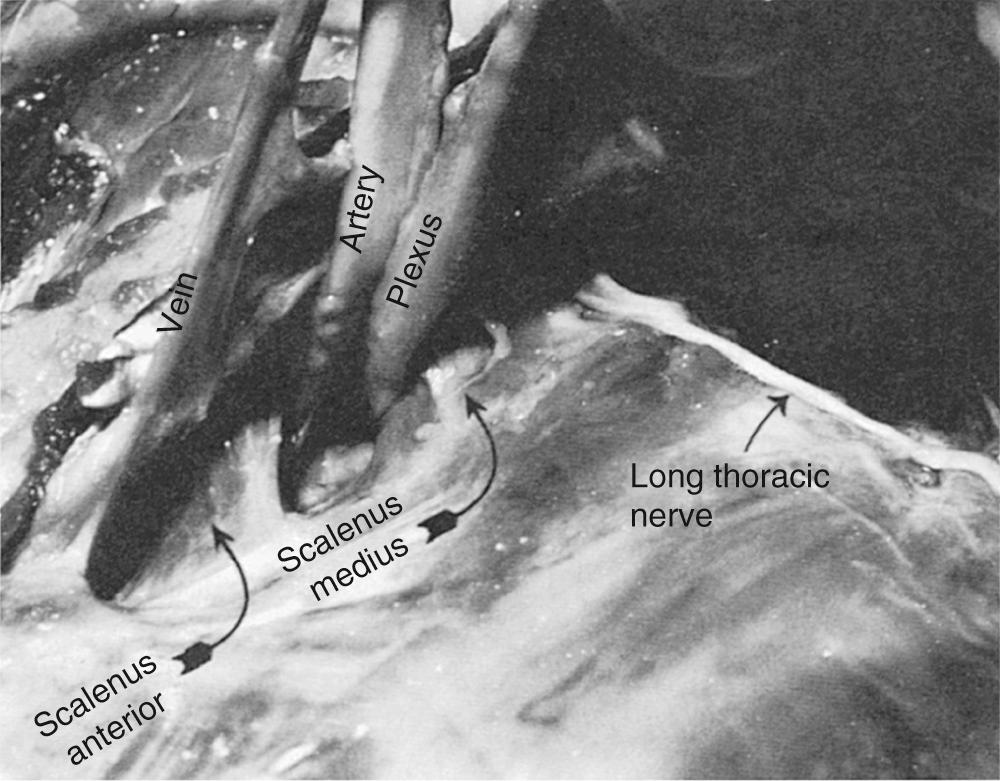
The cervicoaxillary canal, particularly its proximal segment (the costoclavicular area), normally has ample space for passage of the neurovascular bundle without compression. Narrowing of this space occurs during functional maneuvers. It narrows during abduction of the arm because the clavicle rotates backward toward the first rib and the insertion of the scalenus anticus muscle. In hyperabduction, the neurovascular bundle is pulled around the pectoralis minor tendon, the coracoid process, and the head of the humerus. During this maneuver, the coracoid process tilts downward and thus exaggerates the tension on the bundle. The sternoclavicular joint, which ordinarily forms an angle of 15 to 20 degrees, forms a smaller angle when the outer end of the clavicle descends (as in drooping of the shoulders in poor posture), and narrowing of the costoclavicular space may occur. Normally during inspiration, the scalenus anticus muscle raises the first rib and thus narrows the costoclavicular space. This muscle can cause an abnormal lift of the first rib, as in cases of severe emphysema or excessive muscular development, which is seen in young adults.
The scalene triangle, which normally occurs between the scalenus anticus anteriorly, the scalenus medius posteriorly, and the first rib inferiorly, permits the passage of the subclavian artery and the brachial plexus, which are in direct contact with the first rib. The space of the triangle is 1.2 cm at its base and approximately 6.7 cm in height ( Fig. 26-3 ). There is a close-fitting relationship between the neurovascular bundle and this triangular space. Anatomic variations can narrow the superior angle of the triangle, cause impingement on the upper components of the brachial plexus, and produce the upper type of scalenus anticus syndrome that involves the trunk containing elements of C5 and C6. If the base of the triangle is raised, compression of the subclavian artery and the trunk containing components of C7, C8, and T1 results in the lower type of scalenus anticus syndrome. Both types have been described by Swank and Simeone.
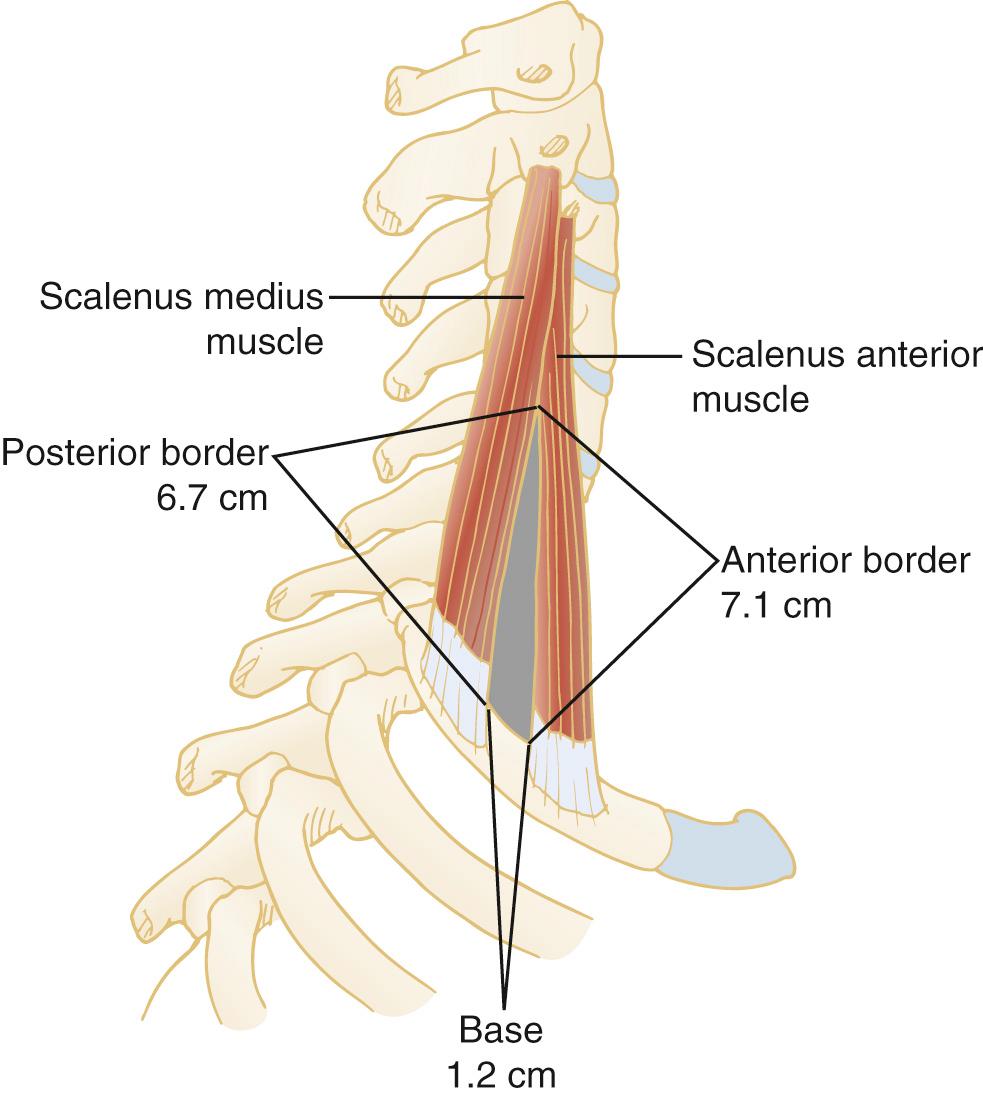
Many factors may cause compression of the neurovascular bundle at the thoracic outlet, but the basic factor is deranged anatomy, to which congenital, traumatic, and, occasionally, atherosclerotic factors may contribute ( Box 26-1 ). Bony abnormalities are present in approximately 30% of patients as cervical rib, bifid first rib, and fusion of first and second ribs; clavicular deformities; or previous thoracoplasties. These abnormalities can be visualized on the plain posteroanterior chest film, but special radiographic views of the lower cervical spine may be required in some cases of cervical ribs.
Potential sites of neurovascular compression
Interscalene triangle
Costoclavicular space
Subcoracoid area
Cervical rib and its fascial remnants
Rudimentary first thoracic rib
Scalene muscles
Anterior
Middle
Minimus
Adventitious fibrous bands
Bifid clavicle or first rib
Exostosis of first thoracic rib
Enlarged transverse process of C7
Omohyoid muscle
Anomalous course of transverse cervical artery
Abnormal lateral insertion of costoclavicular ligament
Flat clavicle
Fracture of clavicle
Dislocation of head of humerus
Crushing injury to upper thorax
Sudden, unaccustomed muscular efforts involving shoulder girdle muscles
Cervical spondylosis and injuries to cervical spine
A therosclerosis
The symptoms of TOS depend on whether the nerves or blood vessels, or both, are compressed in the cervicoaxillary canal. Neurogenic manifestations are observed more frequently than vascular ones. Symptoms consist of pain and paresthesias, which are present in approximately 95% of cases, and motor weakness and occasionally atrophy of hypothenar and interosseous muscles, which is the ulnar type of atrophy, in approximately 10%. The symptoms occur most commonly in areas supplied by the ulnar nerve, which include the medial aspects of the arm and hand, the fifth finger, and the lateral aspects of the fourth finger. The onset of pain is usually insidious and commonly involves the neck, shoulder, arm, and hand. The pain and paresthesias may be precipitated by strenuous physical exercise or sustained physical effort with the arm in abduction and the neck in hyperextension. Symptoms may be initiated by sleeping with the arms abducted and the hands clasped behind the neck. In other cases, trauma to the upper extremities or the cervical spine is a precipitating factor. Physical examination may be noncontributory. When present, objective physical findings usually consist of hypesthesia along the medial aspects of the forearm and hand. Atrophy, when evident, is usually described in the hypothenar and interosseous muscles with clawing of the fourth and fifth fingers. In the upper type of TOS, in which components of C5 and C6 are involved in compression, pain is usually in the deltoid area and the lateral aspects of the arm. The presence of this pain should induce action to exclude a herniated cervical disc. Entrapment of C7 and C8 components that contribute to the median nerve produces symptoms in the index finger and sometimes the middle finger. Components of C5, C6, C7, C8, and T1 can occur at the thoracic outlet by a cervical rib and produce symptoms of various degrees in the distribution of these nerves ( Fig. 26-4 ).
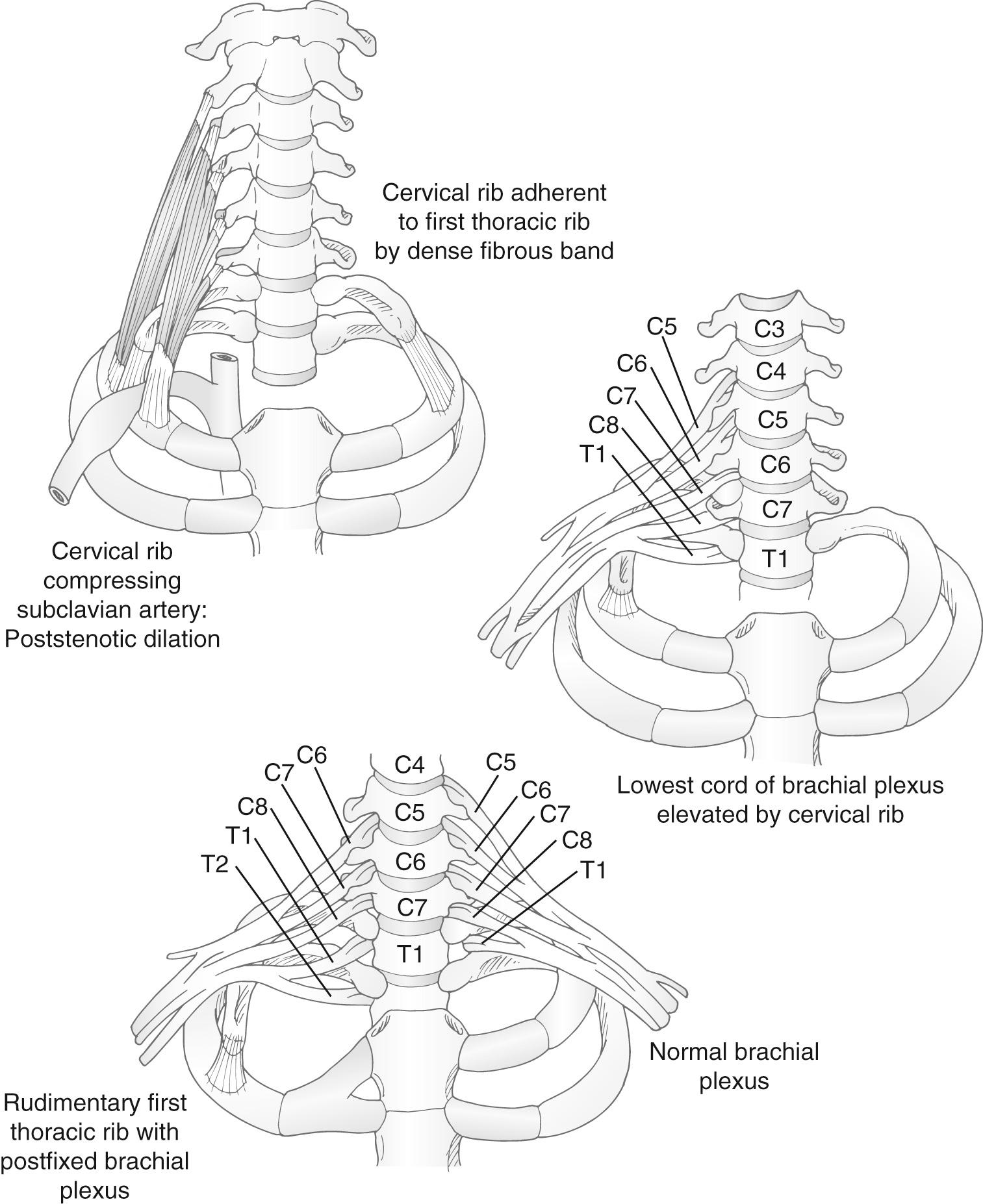
In some patients, the pain is atypical, involving the anterior chest wall or parascapular area, and is termed pseudoangina because it simulates angina pectoris. These patients may have normal coronary arteriograms and ulnar nerve conduction velocities decreased to values of 48 m/sec and less, which strongly suggests the diagnosis of TOS. The shoulder, arm, and hand symptoms that usually provide the clue for the diagnosis of TOS may initially be absent or minimal compared with the severity of the chest pain. The diagnosis of TOS is frequently overlooked; many of these patients are committed to becoming “cardiac cripples” without an appropriate diagnosis, or they develop severe psychological depression when told that their coronary arteries are normal and that they have no significant cause for their pain.
Symptoms of arterial compression include coldness, weakness, easy fatigability of the arm and hand, and pain that is usually diffuse. Raynaud phenomenon is noted in approximately 7.5% of patients with TOS. Unlike Raynaud disease, which is usually bilateral and symmetrical and elicited by cold or emotion, Raynaud phenomenon in neurovascular compression is usually unilateral and is more likely to be precipitated by hyperabduction of the involved arm, turning of the head, or carrying of heavy objects. Sensitivity to cold may also be present. Symptoms include sudden onset of cold and blanching of one or more fingers, followed slowly by cyanosis and persistent rubor. Vascular symptoms in neurovascular compression may be precursors of permanent arterial thrombosis. Arterial occlusion, usually of the subclavian artery, when present, is manifested by persistent coldness, cyanosis or pallor of the fingers, and in some instances, ulceration or gangrene. Palpation in the parascapular area may reveal prominent pulsation, which indicates poststenotic dilation or aneurysm of the subclavian artery ( Fig. 26-5 ).
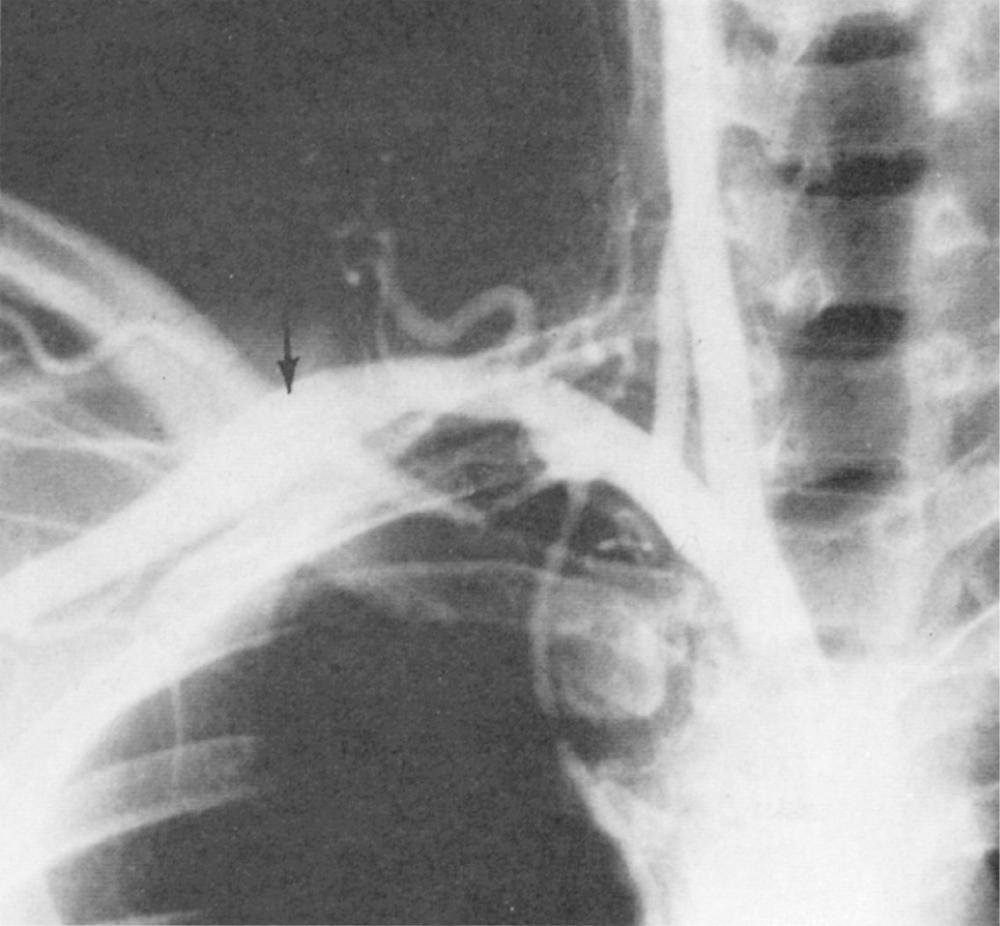
Less frequently, the symptoms are those of venous obstruction or occlusion, commonly recognized as effort thrombosis, or Paget-Schroetter syndrome. The condition characteristically results in edema, discoloration of the arm, distention of the superficial veins of the limb and shoulder, and some degree of aches and pains. In some patients, the condition is observed on waking; in others, it follows sustained efforts with the arm in abduction. Sudden backward and downward bracing of the shoulders or heavy lifting or strenuous physical activity involving the arm may constrict the vein and initiate venospasm, with or without subsequent thrombosis. On examination, in cases of definite venous thrombosis, there is usually moderate tenderness over the axillary vein, and a cordlike structure may be felt that corresponds to the course of the vein. The acute symptoms may subside in a few weeks or days as the collateral circulation develops. Recurrence follows with inadequacy of the collateral circulation.
Objective physical findings are more common in patients with primarily vascular rather than neural compression. Loss or diminution of radial pulse and reproduction of symptoms can be elicited by the three classic clinical maneuvers: the Adson or scalene test, the costoclavicular test, and the hyperabduction test.
The diagnosis of TOS includes history, physical and neurologic examinations, radiography of the chest and cervical spine, electromyography, and ulnar nerve conduction velocity (UNCV). In some cases with atypical manifestations, other diagnostic procedures such as cervical myelography, periphera or coronary arteriography, or phlebography should be considered. A detailed history and physical and neurologic examinations can often result in a tentative diagnosis of neurovascular compression. This diagnosis is strengthened when one or more of the classic clinical maneuvers is positive and is confirmed by the finding of decreased UNCV.
The clinical evaluation is best based on the physical findings of loss or decrease of radial pulses and reproduction of symptoms that can be elicited by the following three classic maneuvers.
The Adson or scalene test ( Fig. 26-6 ) tightens the anterior and middle scalene muscles and thus decreases the interspace and magnifies any preexisting compression of the subclavian artery and brachial plexus. The patient is instructed to take and hold a deep breath, extend the neck fully, and turn the head toward the side. Obliteration or decrease of the radial pulse suggests compression.
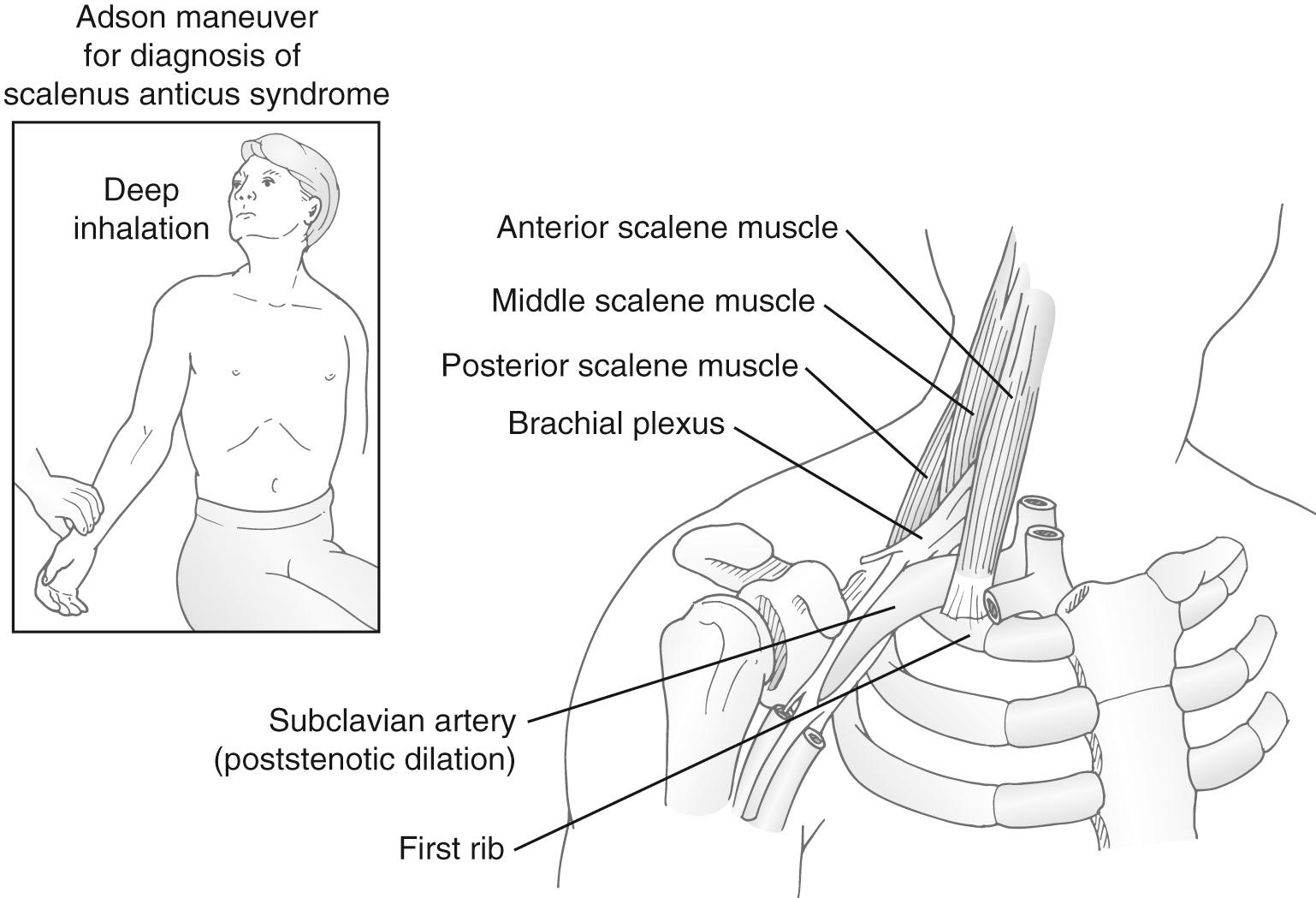
For the costoclavicular test (military position; Fig. 26-7 ), the shoulders are drawn downward and backward. This maneuver narrows the costoclavicular space by approximating the clavicle to the first rib and thus tends to compress the neurovascular bundle. Changes in the radial pulse with production of symptoms indicate compression.
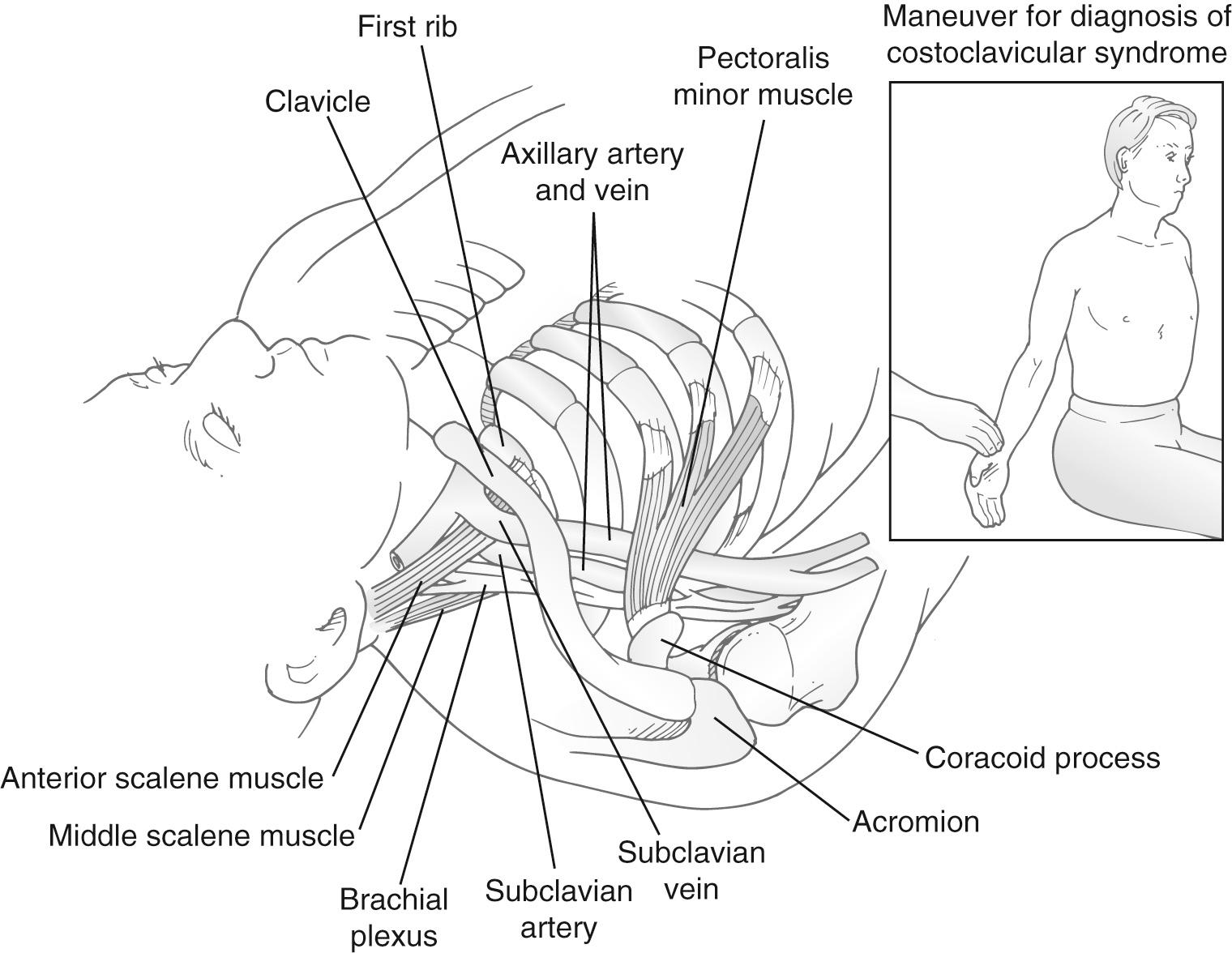
For the hyperabduction test ( Fig. 26-8 ), the arm is hyperabducted to 180 degrees, resulting in the components of the neurovascular bundle being pulled around the pectoralis minor tendon, the coracoid process, and the head of the humerus. A decrease in the radial pulse suggests compression.
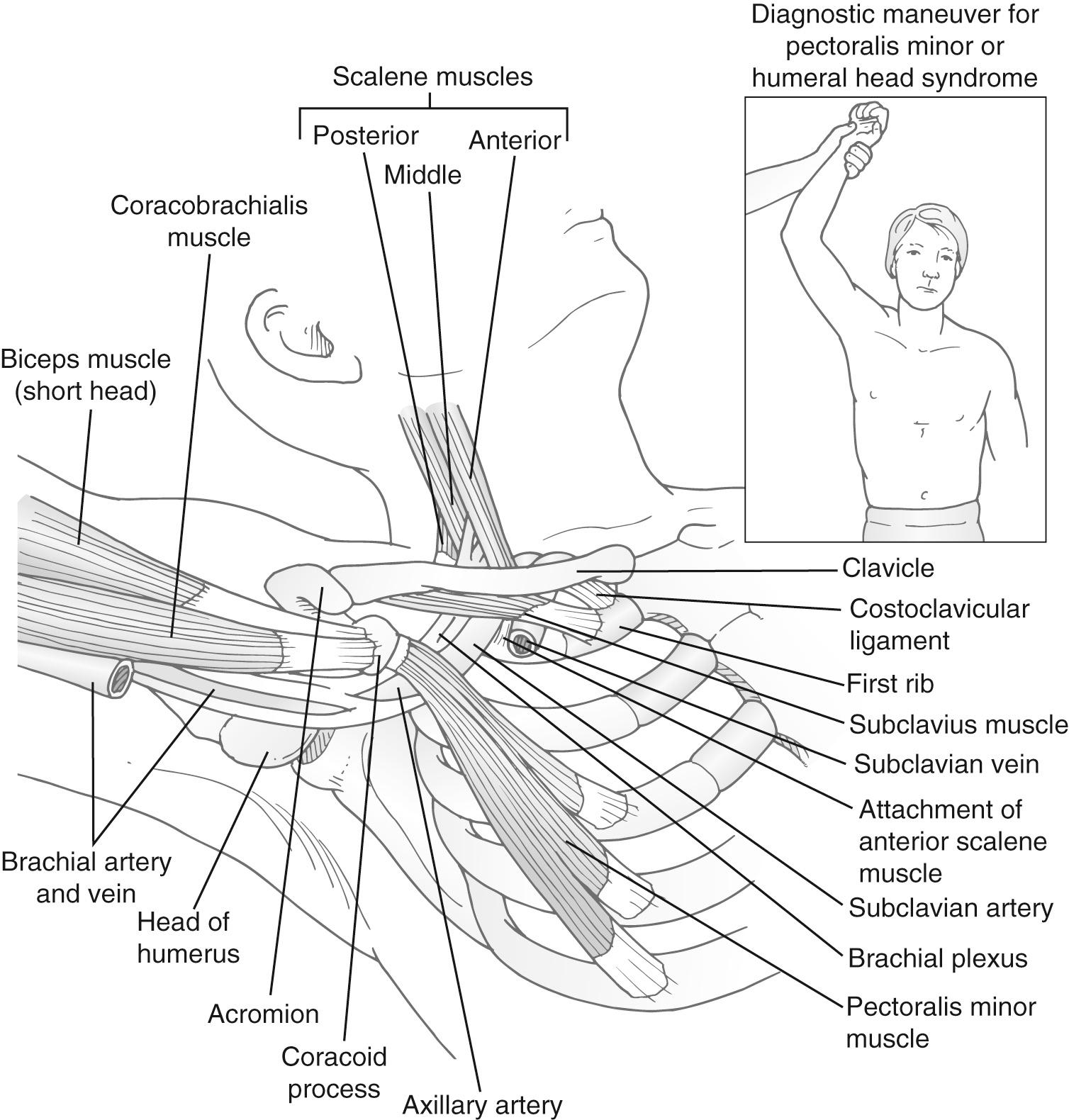
Films of the chest and cervical spine are helpful in revealing bony abnormalities, particularly cervical ribs ( Fig. 26-9 ) and bony degenerative changes. If osteophytic changes and intervertebral space narrowing are present on plain cervical films, a cervical computed tomographic scan should be obtained to rule out bony encroachment and narrowing of the spinal canal and the intervertebral foramina.
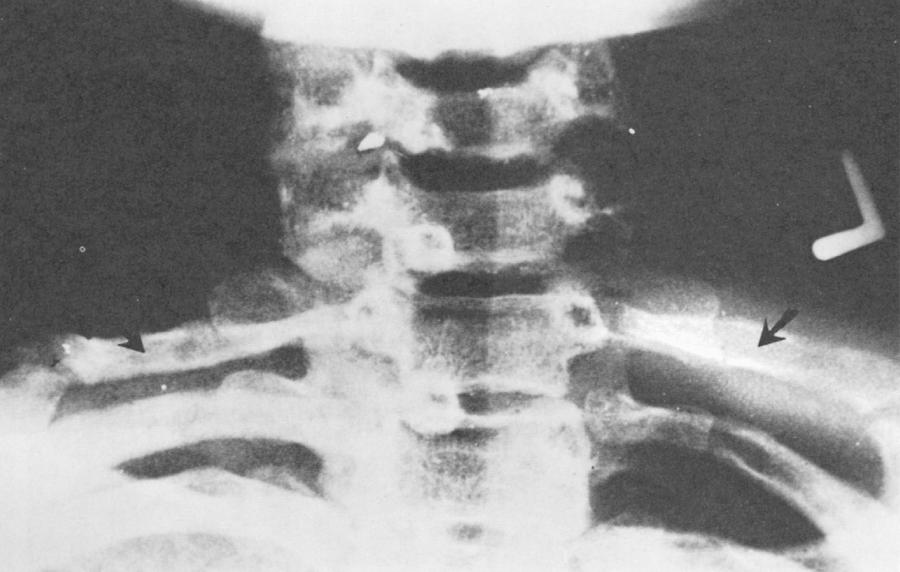
This test is widely used in differential diagnosis of the causes of arm pain, tingling, and numbness with or without motor weakness of the hand. Such symptoms can result from compression at various sites: in the spine; at the thoracic outlet; around the elbow, where it causes tardy ulnar nerve palsy; or on the flexor aspects of the wrist, where it produces carpal tunnel syndrome. For diagnosis and localization of the site of compression, cathodal stimulation is applied at various points along the course of the nerve. Motor conduction velocities of the ulnar, median, radial, and musculocutaneous nerves can be measured reliably. Caldwell and colleagues have improved the technique of measuring UNCV for evaluation of patients with thoracic outlet compression. Conduction velocities over proximal and distal segments of the ulnar nerve are determined by recording the action potentials generated in the hypothenar or first dorsal interosseous muscles. The points of stimulation are the supraclavicular fossa, middle upper arm, below the elbow, and at the wrist ( Fig. 26-10 ).
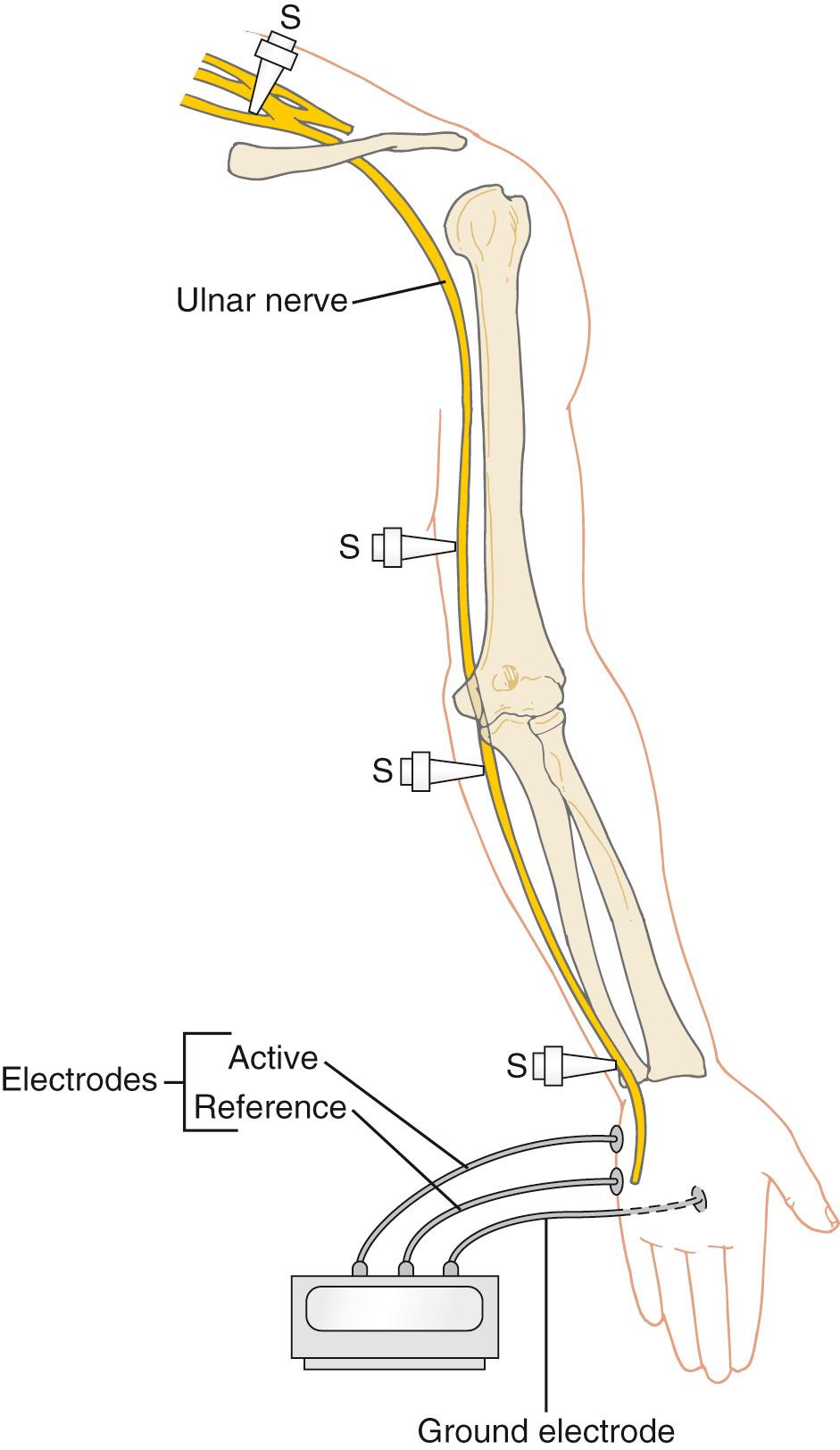
Electromyographic examination of each upper extremity and determination of the conduction velocities are done with the Meditron 201 AD or 312 or the TECA-3 electromyograph. Coaxial cable with three needles or surface electrodes is used to record muscle potentials, which appear on the fluorescent screen ( Fig. 26-11 ).
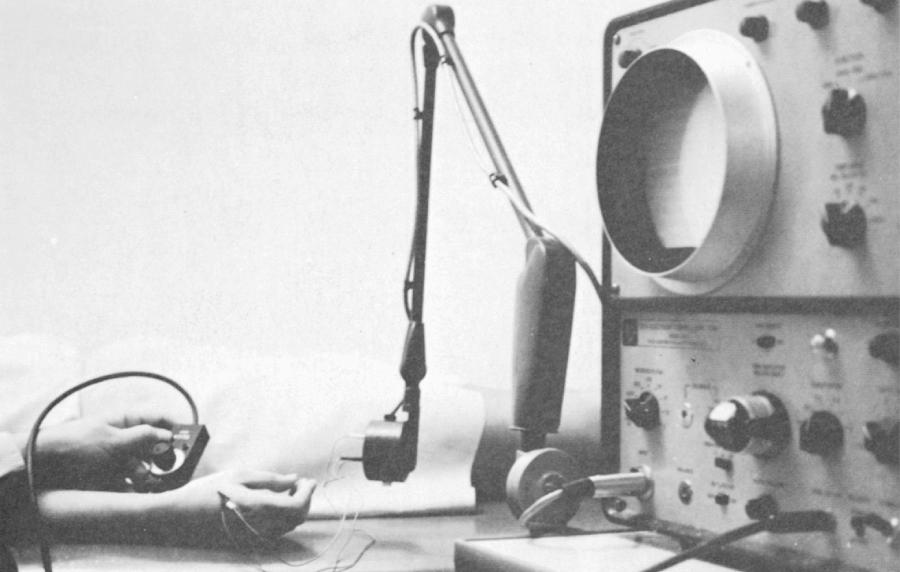
The conduction velocity is determined with the Krusen-Caldwell technique. The patient is placed on the examination table with the arm fully extended at the elbow and in approximately 20 degrees of abduction at the shoulder to facilitate stimulation over the course of the ulnar nerve. The ulnar nerve is stimulated at the four points by a special stimulation unit ( Fig. 26-12 ) that imparts an electrical stimulus with strength of 350 V with the patient's load, which is approximately equal to 300 V with the patient's load with a skin resistance of 5000 Ω. Supramaximal stimulation is used at all points to obtain maximal response. The duration of the stimulation is 0.2 msec, except for muscular individuals, for whom it is 0.5 msec. Time of stimulation, conduction delay, and muscle response appear on the TECA screen; time markers occur each millisecond on the sweep.
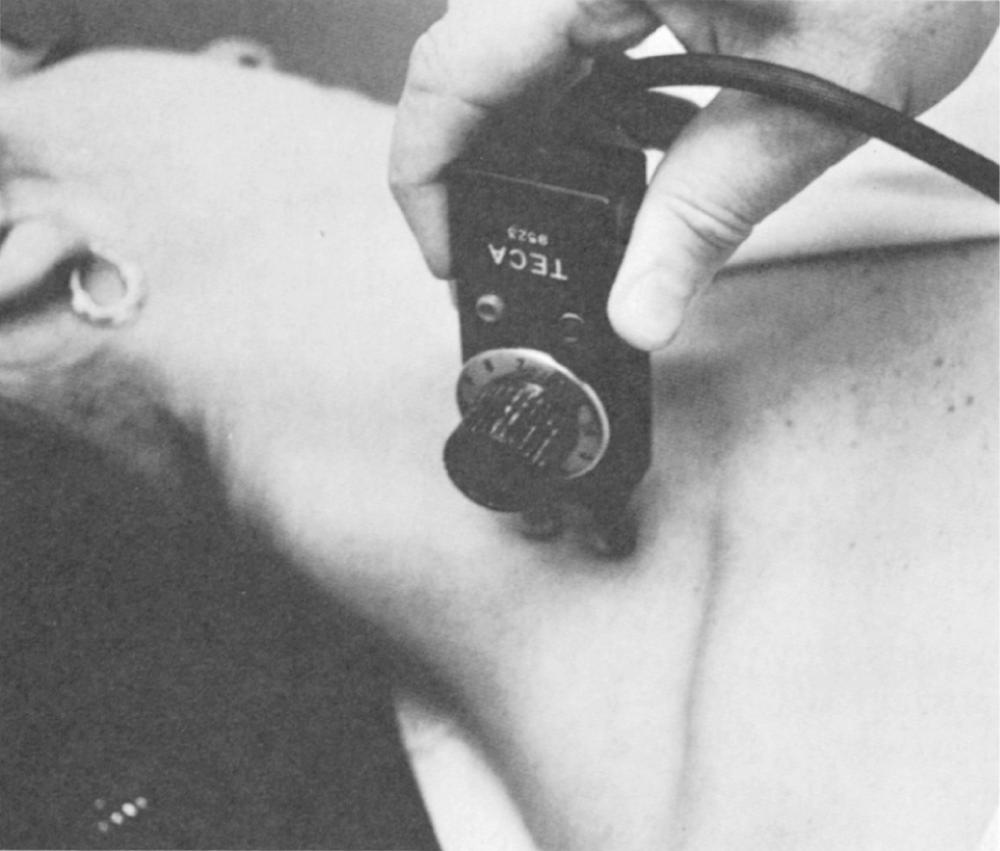
The latency period to stimulation from the four points of stimulation to the recording electrode is obtained from the TECA digital recorder or calculated from the tracing on the screen.
Become a Clinical Tree membership for Full access and enjoy Unlimited articles
If you are a member. Log in here